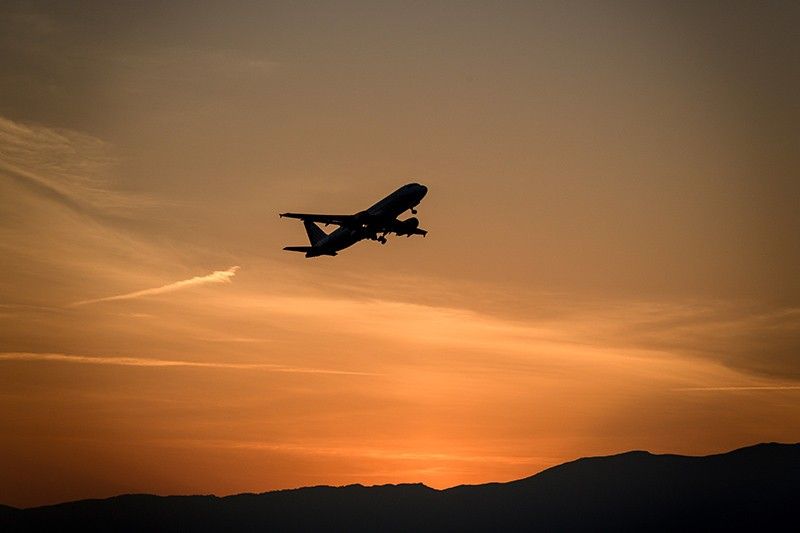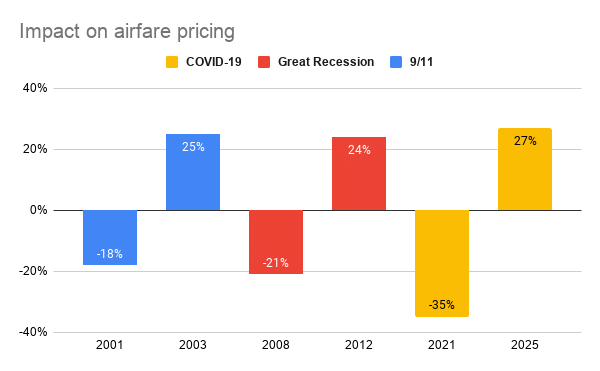Low airfare seen until 2021 amid COVID-19, study says

MANILA, Philippines — Dollar Fight Club, a website that delivers cheap flight alerts, recently released a report on its analysis on airfare “to predict how the COVID-19 outbreak will affect travels and airlines when the world opens back up to travel in 2020 and beyond.”
It particularly compared past airline industry data from both the 9/11 attack in 2001 and the great recession of 2008.
Airline industry downturns
Based on its report, airfare prices globally for both international and domestic flights will decrease by 35% on average through 2021 and then sharply increase 27% on average (above 2019 levels) through 2025 as demand rebounds. The DFC used the assumption that travel will resume by May 31 this year.

Data source: United States Bureau of Transportation Statistics
This year until the next, the DFC said holiday flights and low fares up to 65% are available.
The search engine for cheap flights said the 2008 great recession passenger traffic did not return to what it was in 2007 until the end of 2013.
During which, the DFC said that the airfare prices dropped by 21% on average from that year until 2009. Airfare increased by 24% in 2012.
Meanwhile, during the 9/11 attack, airfare prices went down by 18% on average in 2001 while airfare hikes by 25% in 2003.
With the COVID-19’s massive impact on the airline industry, the DFC said airlines must “adapt drastically to restore profitability and revenue once travel demand rebounds over the next five years.”
It forecasts airline mergers, reduction of commercial flights and increase of advertised flights.
“Airlines will significantly cut back on available capacity by reducing the number of flights and routes to increase load factor. This will help increase revenue but will lead to ticket prices increasing,” the study read.
During a Senate Committee on Public Services inquiry on Monday, Air Carriers Association of the Philippines executive director and vice chairman Roberto Lim cited the data from International Air Transport Association that losses for the local airline industry this year could hit as much as P250 billion.
Last month, IATA estimated that revenue amount and passenger demand in the Philippines may drop by 47% this year compared to last year. This may result in a revenue loss of $4.48 billion.
IATA in March only estimated a 36% year-on-year decline in passenger demand or a revenue loss of $3.51 billion.
Aside from this, the airline association also estimated a potential 548,3000 job loss in the local airline industry.
What it means for passengers
Meanwhile, the DFC said that passengers are seen to have less travel options, more bag fees and miscellaneous charges experience fewer flight delays and cancellations.
In its outlook for passengers, the DFC noted that the short term outcome of the pandemic is that the flight prices decrease significantly due to the airline industry shocks.
However, in the long term, it said the airlines are about to get smaller.
“Customers will have fewer choice of airlines, flight times, and available routes and markets. All of that means passengers will pay more when they return to the air,” the DFC said.
With the loss of double its revenue, airlines are expected to ramp up additional fees to get back to profitability as travel demand returns.
This occurred during the great recession when airlines made $3.4 billion in 2011 for charging checked in baggage when it only earned $464 million in 2007 prior to the recession.
The extra charges include, additional seat fees, charges for snacks and drinks and increased ticket changed fees.
Future travel plans
Despite this, its survey conducted in March, showed that over 60% of the 20,000 respondents, still feel comfortable traveling over the next six months if restrictions are taken down.
Around 80% of them have canceled trips scheduled for April or May departure dates while 44% have a trip scheduled for June to December.
More than 40% of the respondents said they would only travel domestically due to COVID-19.
The DFC surveyed 20,000 of its 1 million most active members to get the insights on how COVID-19 is affecting the travel demand in the short and long term. — Rosette Adel
- Latest
- Trending































